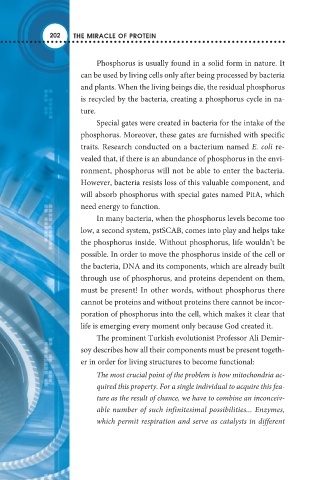Page 204 - The Miracle of Protein
P. 204
202 THE MIRACLE OF PROTEIN
Phosphorus is usually found in a solid form in nature. It
can be used by living cells only after being processed by bacteria
and plants. When the living beings die, the residual phosphorus
is recycled by the bacteria, creating a phosphorus cycle in na-
ture.
Special gates were created in bacteria for the intake of the
phosphorus. Moreover, these gates are furnished with specific
traits. Research conducted on a bacterium named E. coli re-
vealed that, if there is an abundance of phosphorus in the envi-
ronment, phosphorus will not be able to enter the bacteria.
However, bacteria resists loss of this valuable component, and
will absorb phosphorus with special gates named PitA, which
need energy to function.
In many bacteria, when the phosphorus levels become too
low, a second system, pstSCAB, comes into play and helps take
the phosphorus inside. Without phosphorus, life wouldn’t be
possible. In order to move the phosphorus inside of the cell or
the bacteria, DNA and its components, which are already built
through use of phosphorus, and proteins dependent on them,
must be present! In other words, without phosphorus there
cannot be proteins and without proteins there cannot be incor-
poration of phosphorus into the cell, which makes it clear that
life is emerging every moment only because God created it.
The prominent Turkish evolutionist Professor Ali Demir-
soy describes how all their components must be present togeth-
er in order for living structures to become functional:
The most crucial point of the problem is how mitochondria ac-
quired this property. For a single individual to acquire this fea-
ture as the result of chance, we have to combine an inconceiv-
able number of such infinitesimal possibilities... Enzymes,
which permit respiration and serve as catalysts in different

